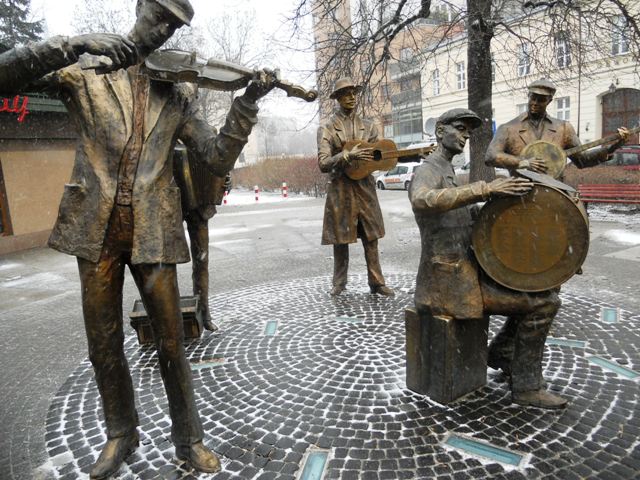 Warsaw's Praga. A place full of contradictions.
Warsaw's Praga. A place full of contradictions.
Paris's Montmartre is a historical fragment of the city, full of old houses, paved sidewalks and winding streets. Formerly the seat of artistic bohemia, today the center of tourism. Warsaw also has its own Montmartre.
Prague is Montmartre in Warsaw. The right bank of the capital to 1791 year was an independent city. More precisely - it is about the central part of the part of the capital located east of the Vistula River. Just a dozen or so years ago, Prague, especially South Praga, it was considered primarily a dangerous district. However, thanks to the revitalization program that has been going on for some time, the situation has changed dramatically. Today, Prague is not only relatively safe, but also full of cultural and tourist attractions. And - simply - fashionable.
Barefoot, but in spurs
Stanislaw Grzesiuk, author of a novel with this slightly perverse title, he was born and spent a large part of his life in Czerniaków, but - for some reason - it is his "non-Varsovians" that they associate with old Praga. Song, which probably everyone knows - "You do not have a cheat over a Varsovian" - today arouses in our imagination a nostalgic image of the Praga troublemaker, which is hard not to like. Wrong, because Czerniaków and Praga lie on two different sides of the Vistula, but well…
Some time ago, a new version of the famous piece was created, in which the voice is given by a singer of Nigerian origin, while the video was shot in Praga. This project is mentioned here for a reason. Its main goal was to show, that Warsaw is a multicultural and truly global city, and on the other hand, that many places (historically important places, because they are a testimony to the old capital) it passes faster and faster.
Prague, however, is somewhere in between: develops, but not quickly enough - it passes away, but too soon. It is suspended in Warsaw's spacetime, awakening an undefined longing in everyone, who had the opportunity to spend a little more time here.
Prague is happening
The word "Prague" comes from roasting, that is, burning the forest to obtain usable land - fields and places for building houses. This is also the origin of the name. Initially, Praga was not an integral part of Warsaw, but a noble village, which developed particularly well in the second half of the 16th century. As a result, already in the middle of the next century, King Władysław IV granted it city rights and the privilege to organize as many as four fairs a year..
Just 8 years later the worst happened. Swedish troops flooded Poland, and King Jan Kazimierz lost the battle of Praga and Skaryszewo. The area was almost completely destroyed. Thus the "golden times" of Prague ended.
Only in 1720 year, renewal began. Due to that, that in the area of former Praga, the routes from Brest converged (to this day, a part of the route leading from Warsaw is called "Trakt Brzeski"), Moscow and Gdańsk, Rich people from the eastern regions of the country began to settle there. As a consequence, many craftsmen and merchants also moved to the site, which in turn triggered a renewed - rapid - economic development. W 1794 year, Warsaw officially annexed Prague, thus significantly increasing its acreage and economic potential. And thus - also important in the international political and commercial arena.
Prague's fortunes have changed over the centuries. Destroyed and rebuilt many times, however, it survived the worst historical turmoil. During World War II - just like the whole of Warsaw - was practically razed to the ground. And yet it is here that we can find most of the original evidence of the pre-war history of the capital.
The factory of culture
Prague and its surroundings are areas known mainly for fairs and crafts. After the war, industrial facilities were also located here, including factories. Today, the most famous factory in Prague is Fabryka Trzciny, which, in fact, has nothing to do with industry. I guess, that we will be talking about the production of culture - and the production of the highest quality.
Founded in 2003 year by the composer Wojciech Trzciński, the Art Center is located in one of the oldest post-industrial buildings in Prague. It is the place, where the paths of various creators of culture - musicians - intersect, artists, photographers, performers, actors…
The center was one of the first major cultural facilities, which from the beginning fit into the climate of the revitalized - both architecturally, and socially - Praga. Today, there are many more similar centers. There are plenty of smaller and larger galleries in Praga, cozy cafes and trendy restaurants. There are also more and more new residential buildings, where young city dwellers willingly settle.
Every year there is also a special event called "Prague Night". Prague's open air in mid-June, galerie, clubs and many other - often unexpected - spaces are in the hands of art and entertainment. There are indoor and outdoor concerts, organizuje się ciekawe wystawy, aerial acrobatics shows and a whole lot of events, which in the unique atmosphere of Warsaw's Praga take on a special meaning.
Because not only Paris has its own Montmartre - Warsaw also has it. And that's Prague.
